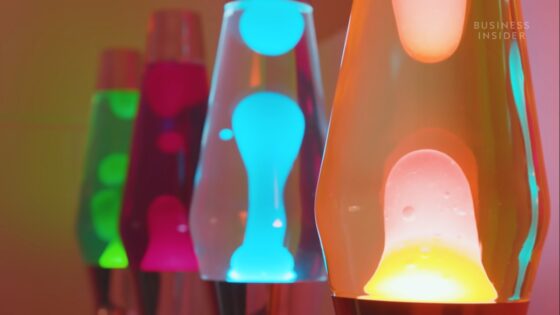Even though we associate the lava lamp with the 80s and 90s, many don’t realize this tantalizing invention has been around since the 1960s.
Imagined by entrepreneur Edward Craven Walker, these lamps took inspiration from an old egg timer made from a liquid-filled cocktail shaker. After seeing it in a pub, Walker took the idea to inventor David George Smith and had him create the device and liquid you see in lava lamps today.

But how are these mesmerizing desk fixtures made? Insider took a trip to Mathmos, a renamed Crestworth which is Craven Walker’s company. Mathmos has been making lava lamps for more than 50 years now, and their production process has remained largely the same:
Glassing the Container

It all starts with glass, which is blown into the lava lamp’s iconic shape by machines. Once the containers have been produced, the human element inspects each glass bottle to ensure they are up to snuff. Since the wax and liquid inside will be constantly heated and cooled, it is imperative the glass containing them can handle the temperature changes.

To cover the container, a metal plate is hand-spun on a spinning tool. This flattens the plate and rounds out the shape of the lava lamp.
Wax and Liquid

With the container finished, the super, secret colored liquid and colored wax can be added inside the lamp. The recipe for the liquid is so well-guarded, very few people on-site actually know what goes into making it.
Despite all the secrecy, one thing is certain: this very dense concoction allows the wax (or the lava, as many people call it) to flow freely around the lamp. To help distribute heat, a metal spray is applied throughout the inside of the glass bottle.

Once the two substances are mixed, lids are screwed on and the lamp is dunked in water. This cleans off any excess materials from the side of the lamp and separates the wax from the liquid.
Adding the Electronics

Business Insider didn’t mention this, but what really gets the liquids inside the lava lamp to move is an incandescent or halogen lamp placed just below the solution.
The heat emanating from the lamp pushes the wax upwards. As the wax gets further away from the heat source, it starts to fall back down. This cycle continues ad infinitum and thanks to the random nature of liquids, you get a lava lamp that produces different patterns every time.
What’s interesting is Mathmos has been producing lava lamps the same way for years. If you have one of their lamps from the 1960s and need some repairs, you could still find replacements for it with no problem. It just goes to show how good design can last for a very long time.




![6 Types of Civil Engineering Drawings [Detailed Guide]](https://www.solidsmack.com/wp-content/uploads/2023/12/Civil-Engineering-Drawings-270x180.jpeg)

